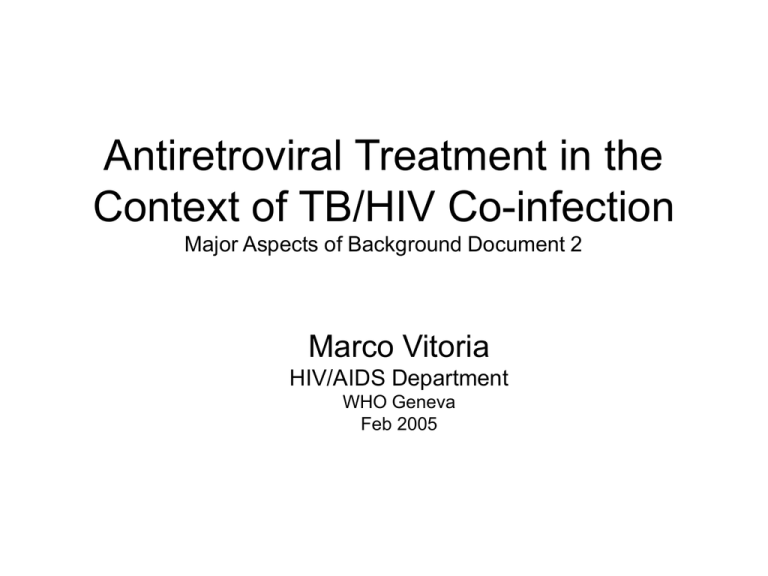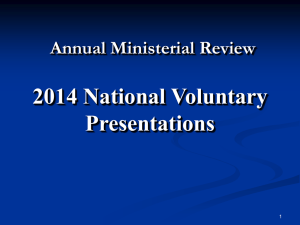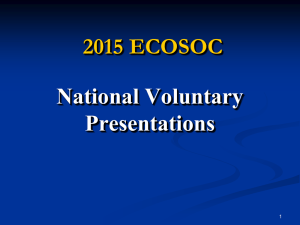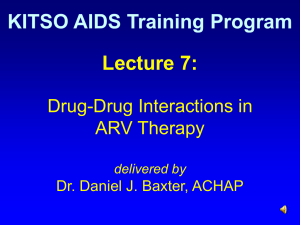Antiretroviral Treatment in the Context of TB/HIV Co-infection Marco Vitoria HIV/AIDS Department
advertisement

Antiretroviral Treatment in the Context of TB/HIV Co-infection Major Aspects of Background Document 2 Marco Vitoria HIV/AIDS Department WHO Geneva Feb 2005 ART for HIV+ with TB • Possible Strategies currently recommended: – Delay ART (and treat TB with RMP based regimens) – Use any ART regimen + anti-TB regimens without RMP – Use a RMP-compatible ART regimen • 2 NRTI + NNRTI (EFV or NVP) -1st line • 2 NRTI + PI/r (SQV/r or LPV/r + RTV) -2nd line • 3 NRTI ( with ABC) – Alternative 1st line Important Concepts to be consider in TB/HIV treatemnt • Rifampin and CYP 450 (3A4, 2B6, 3A5) • CYP and Host Genetics("Farmacogenomics") • ART pK and Safety (hepatic) in patients with TB/HIV co-infection under dual treatment (ART & RMP) Objectives • Review of the Literature (Pub Med) • Overview of concomitant use of NNRTI and PI with antituberculous drugs (emphasis in safety and efficacy of NNRTI and PI when used concomitantly with RMP) • What we need to know ? • List of major ongoing & planned studies on ART in TB/HIV patients • What to do in the meantime? Major Questions • Nevirapine versus Efavirenz – Efficacy in TB/HIV • Nevirapine and Rifampin – Resistance & Efficacy (pK interactions) – Toxicity Risk • Efavirenz and Rifampin – Safest Dose (efficacy vs adverse effects) • PI and Rifampin – Efficacy and safety (hepatic) NVP vs EFV: What is the better drug in HIV Treatment ? Current WHO Guidelines • NVP: 1st line regimens in RPS, available as FDC (adherence, cost, operational aspects). Good tolerance, favourable lipid profile (reducing coronary risk). Led in dose. Hepatotoxicity and Rash. • EFV: 1st line regimen - Preferential drug in TB/HIV, contraindicated in pregnancy and psychiatric disorders. Once daily drug . CNS symptoms, hypercolesterolemia and ginecomastia. NVP vs EFV: What is the better drug in HIV Treatment ? • Metanalysis: Equivalent virologic suppression and short term efficacy at 24 and 48 weeks • One non controlled study showed limited virologic and immunologic advantage of EFV in the first 12 months, but no relevant efficacy difference throughout 18 months comparison NVP vs EFV: What is the better drug in HIV Treatment ? • Pharmacokinetics: NVP and EFV partially metabolized by CYP 3A4 and CYP 2B6 and mild inducers of this enzyme system • RMP pK don't change significantly. • Small pK studies show large interpatient variability NVP vs EFV: What is the better drug in HIV Treatment ? • Different side effect profile: – Hypersensitivity syndrome & skin rash • NVP (7%) versus EFV (4%) – Hepatitis • NVP (2%) versus EFV (0,3%) – CNS Symptoms • EFV (40-50% in the first weeks of treatment. Suicidal attempting 1-3%) • Clinical Practice: Drugs are equivalent options: choice should be based on safety profile and specific contraindications NVP and RMP: Concerns about Resistance, Efficacy and Toxicity • Drug Interaction and NVP Resistance/Faliure: – NVP: High Therapeutic Index – Reduction of NVP serum levels (31-58%) but generally above the viral inhibitory concentration – Good immunological and virological response in small studies (non controlled) – No dose adjustment recommended by majority of experts – Large intervariability independently of RMP concomitant use (further investigation required) Rifampin – NVP case serie from HIVNAT pK Lab (n=60) Nevirapine + Rifampicin 16 NVP conc. 14 12 10 8 6 4 2 0 0 3 6 9 12 15 Time (h) 85% of NVP levels in therapeutic range David Burger; 2005 BKK Symp HIV Med, data provided by Saskia Autar NVP and RMP: Concerns about Resistance, Efficacy and Toxicity General NVP Toxicity Profile • Concern about RMP-NVP use (lack of solid data about concomitant use) • Mechanisms: Direct and immune mediated hepatic & skin involvement – Stratified & comparative risk of any hepatic reaction with NVP use in HIV+ patients (studies without TB): • NVP versus other ARV (10x) • NVP in with CD4 > 400/mm3 (3x) • NVP in with CD4 > 250/mm3 (12x) – Presence of liver disease • • • • • HBV and HCV co-infection Histological stage and fibrosis pK of NNRTI not significantly modified NVP accelerating hepatic fibrosis ? No data on additive risk of hepatotoxicity of TB drugs in HIV-HBV or HIV-HCV coinfection – Elevated plasma levels (hepatic disease or slower clearance- CYP2B6) – NVP plasma levels > 6 mg/l (92% of liver toxicity) – NVP levels > 5.3 mg/l in 1st 90 days (2.5 x for rash) – However other studies (observational cohorts) didn't find any correlation NVP and RMP: Concerns about Resistance, Efficacy and Toxicity NVP Toxicity Profile (cont'd) • Increase in liver enzymes are common but generally asymptomatic and in low/moderate grade (small and non controlled studies). • Analysis of Clinical Trials with NVP (17 studies) – 10% of NVP treated patients with elevated ALT (> 5x), but more than 2/3 asymptomatic (almost half of symptomatic with concomitant rash). • Analysis of Observational Studies: NVP use not associated with significant increase in the risk of severe clinical hepatic events when compared with other ARV drugs. • Small non controlled studies shown increase in ALT and clinical hepatitis when NVP used with RMP • WHO recommendation: NVP and RMP should be use with caution only no alternative available and with close monitoring EFV dose in TB/HIV co-infection treated with RMP (600 versus 800 mg) • • Similar pK phenomena observed with NVP and RMP interaction (reduction in EFV levels:13-33%). Safety profile: – Apparently is dose related – CNS adverse effects are frequent in the beginning of treatment (50%) but transitory (5-10% after 3 months). – Neuropsychiatry symptoms after 3 months in 25% of patients. – Sleep abnormalities associated with higher plasma levels (>4 mg/l). • • Small non controlled studies shown effective, pharmacological, clinical, immunological and virologic response with conventional 600 mg EFV dose pK studies accordingly body weight: EFV plasma concentration patients using RMP: – Patients with less than 50-60 Kg: similar to patients without TB (600 mg is adequate) – More than 50-60 kg : need better evaluation (small study shown EFV concentrations 50% lower) • • Large interpatient variability in small pK studies Clearance of EFV was higher in Caucasians than in Afro-Americans and Hispanics (impact on safety profile) EFV and Rifampin: TDM and Efficacy Study Plasma EFV (C12) levels of EFV 600 vs. 800 mg group mg/L 25 TDM at Week 2 after treatment EFV 800 20 n = 40 15 10 EFV 600 92% of patients with therapeutic levels n = 38 8% < 1mg/L 5 Appropriate EFV level 1-4 3.02 0% < 1mg/L 3.39 0 Weerawat Manosuthi et al. Bangkok AIDS Conf .2004 (TDM done at HIVNAT; study Supported by HSRI, Thailand); D. Burger, 2005 BKK Symp HIV Med Protease Inhibitors and Rifampin: Safety and Clinical Efficacy • Impact of RMP on PI levels: 80-90% reduction • "Pharmacoenhancement" with low dose RTV can overcome RMP induction effect of some PIs: – SQV/r (1000/100 BID, 400/400 BID, 1600/200 MID) – LPV/r + RTV (400/100 + 300 BID) • • Pharmacological booster increase the side effect risk and can compromise adherence - Major side effect associated with boosted PIs: Hepatotoxicity – HBV & HCV co-infection associated with higher risk of elevation of liver enzymes (higher rates of grade 3 / 4 ALT elevations) – Comparative studies: No difference in ARV discontinuation, other hepatic events or death when compared without HBV & HCV co-infection – pK of PIs can be altered by hepatic disease but no change in doses are recommended for SQV/r and LPV/RTV (limited data) – Large majority of patients treated without side effects (low dose RTV didn't affect hepatic safety profile of PI based therapy) Protease Inhibitors and Rifampin: Safety and Clinical Efficacy • Retrospective and comparative study in patients using RMP - 3 NRTI, 2NRTI/NNRTI and 2NRTI/SQVr: well tolerated and safe but data is limited • TB/HIV using RMP and SQV/r: – SQV/r 1600/200 (SQV AUC reduced by50% but still under therapeutic concentrations and clincial efficacy mantained) – SQV/r 1000/100 in HIV+: clinical efficacy and safety , but small Phase I study in HIV negative patients shown high rate of clinical hepatitis (AE less pronounced in HIV+?) – SQV/r 400/400, and LPV/RTV 400/400 – Apparently effective and safe but even more limited data Conclusion: More studies are needed… • • • • Few published data (safety profile) Limited number of patients No controlled studies Mixed and conflicting results What We Need to Know? • ART & RMP: Studies on safety, efficacy, pK evaluation and pharmacovigilance (better define ART strategy in TB/HIV) • Review the role of Triple Nukes in TB/HIV co-infection (DART Trial) • Ongoing and planned studies on ART for HIV-infected TB patients (see database) What to Do in the Mean Time? • Need more clear recommendations and best informed practice in ART management of TB/HIV • Better inform HCW about potential risks and benefits of ART & RMP and mixed/conflicting results in scientific literature • EFV - Preferential drug (no dose adjustment for patients with less 50-60 kg) • PI/r & NVP in patients using RMP– Use with caution • Establish the potential role of some triple nukes regimens in TB/HIV treatment



